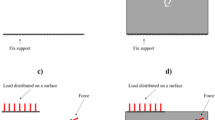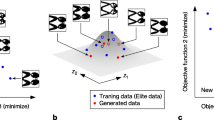Abstract
Three-dimensional (3D) solid model generation technology is the foundation to realize intelligently generated structural design, but this problem has not yet been effectively solved. This paper proposes a comprehensive generation method named 3D-JointGAN for 3D solid models by combining a 3D generative adversarial network (GAN) and reverse engineering (RE) technology. First, the basic idea, relevant theories and specific implementation process of 3D-JointGAN are introduced. Then, the approach is applied to the generation of a three-branch cast-steel joint in practical engineering, and the mechanical properties of representative joints selected after evaluation are synthetically calculated. Finally, reduced-scale models of the representative joints are manufactured using 3D printing technology to verify the manufacturability of the generated models. By comparison with three other types of joints common in engineering, the results show that the proposed method has outstanding generation and optimization abilities and can generate a variety of innovative and highly vivid 3D solid models. Furthermore, the representative joints chosen after assessment have better mechanical properties. The method proposed in this paper solves the bottleneck problem of intelligently generated structural design and has broad application prospects.




























Similar content being viewed by others
Data availability
Some or all data, models, or code that support the findings of this study are available from the corresponding author upon reasonable request.
Change history
21 January 2023
A Correction to this paper has been published: https://doi.org/10.1007/s10489-023-04459-x
References
Mei QY (2019) A study on intelligent Design of Radar Structures. Modern radar 41(06):86–90. https://doi.org/10.16592/j.cnki.1004-7859.2019.06.017
Hadi S, Rigoberto B (2018) Emerging artificial intelligence methods in structural engineering. Eng Struct 171(11):170–189. https://doi.org/10.1016/j.engstruct.2018.05.084
As I, Pal S, Basu P (2018) Artificial intelligence in architecture: generating conceptual design via deep learning. Int J Archit Comput 16(4):306–327. https://doi.org/10.1177/1478077118800982
Burnap A, Liu Y, Pan YX, Lee H, Gonzalez R et al (2016) Estimating and exploring the product form design space using deep generative models. In: the ASME 2016 international design engineering technical conferences and computers and information in engineering conference. ASME, pp V02AT03A013. https://doi.org/10.1115/DETC2016-60091
Oh S, Jung Y, Kim S, Lee I, Kang N (2019) Deep generative design: integration of topology optimization and generative models. J Mech Des 141(11):111405. https://doi.org/10.1115/1.4044229
Wang YQ, Du WF, Wang H, Zhao YN (2021) Intelligent generation method of innovative structures based on topology optimization and deep learning. Materials 14(24):7680. https://doi.org/10.3390/ma14247680
Wu JJ, Zhang CK, Xue TF, Freeman WT, Tenenbaum JB (2016) Learning a probabilistic latent space of object shapes via 3D generative-adversarial modeling. In: the 30th international conference on neural information processing systems. Curran associates Inc., pp 82-90. https://doi.org/10.5555/3157096.3157106
Galliani S, Lasinger K, Schindler K (2015) Massively parallel Multiview stereopsis by surface Normal diffusion. In: the 2015 IEEE international conference on computer vision. IEEE, pp 873-881. https://doi.org/10.1109/ICCV.2015.106
Ji M, Gall J, Zheng H, Liu Y, Fang L (2017) SurfaceNet: an end-to-end 3D neural network for Multiview stereopsis. In: the 2017 IEEE international conference on computer vision. IEEE, pp 2326-2334. https://doi.org/10.1109/ICCV.2017.253
Yao Y, Luo Z, Li S, Fang T, Quan L (2018) MVSNet: Depth Inference for Unstructured Multi-view Stereo. In: the 2018 European conference on computer vision. Springer, pp 785–801. https://doi.org/10.1007/978-3-030-01237-3_47
Jing Z, Jin X, Yi F (2018) Learning adversarial 3D model generation with 2D image enhancer. In: the 32nd AAAI conference on artificial intelligence. AAAI press, pp 7615-7622. https://doi.org/10.5555/3504035.3504968
Choy CB, Xu DF, Gwak JY, Chen K, Savarese S (2016) 3D-R2N2: A Unified Approach for Single and Multi-view 3D Object Reconstruction. In: the 2016 European conference on computer vision. Springer, pp 628–644. https://doi.org/10.1007/978-3-319-46484-8_38
Fan HQ, Su H, Guibas L (2017) A Point Set Generation Network for 3D Object Reconstruction from a Single Image. In: the 2017 IEEE conference on computer vision and pattern recognition, Hawaii. IEEE, pp 2463–2471. https://doi.org/10.1109/CVPR.2017.264
Chen R, Han SF, Xu J, Su H (2019) Point-based multi-view stereo network. In: the 2019 IEEE/CVF international conference on computer vision. IEEE, pp 1538-1547. https://doi.org/10.1109/ICCV.2019.00162
Wang NY, Zhang YD, Li ZW, Fu YW, Liu W (2018) Pixel2Mesh: generating 3D mesh models from single RGB images. In: the European conference on computer vision. Springer, pp 55-71. https://doi.org/10.1007/978-3-030-01252-6_4
Kato H, Ushiku Y, Harada T (2018) Neural 3D Mesh Renderer. In: the 2018 IEEE/CVF conference on computer vision and pattern recognition. IEEE, pp 3907–3916. https://doi.org/10.1109/CVPR.2018.00411
Yang B, Wen HK, Wang S, Clark R, Markham A (2017) 3D object reconstruction from a single depth view with adversarial learning. In: the 2017 IEEE international conference on computer vision workshop. IEEE, pp 679-688. https://doi.org/10.1109/ICCVW.2017.86
Kanazawa A, Black MJ, Jacobs DW, Malik J (2018) End-to-end recovery of human shape and pose. In: the 2018 IEEE/CVF conference on computer vision and pattern recognition. IEEE, pp 7122–7131. https://doi.org/10.1109/CVPR.2018.00744
Moschoglou S, Ploumpis S, Nicolaou M, Papaioannou A, Zafeiriou S (2020) 3DFaceGAN: adversarial nets for 3D face representation, generation, and translation. Int J Comput Vis 128(10):2534–2551. https://doi.org/10.1007/s11263-020-01329-8
Nie YY, Han XG,Guo SH,Zheng YJ, Chang J et al (2020) Total 3D understanding: joint layout,object pose and mesh reconstruction for indoor scenes from a single image. In: the 2020 IEEE/CVF conference on computer vision and pattern recognition. IEEE, pp 52–61. https://doi.org/10.1109/CVPR42600.2020.00013
Kabir HMD, Khosravi A, Nahavandi S, Kavousi-Fard A (2021) Partial adversarial training for neural network-based uncertainty quantification. In the IEEE transactions on emerging topics in computational intelligence. IEEE, pp 595-606. https://doi.org/10.1109/TETCI.2019.2936546
Wang GG, Lu M, Dong YQ, Zhao XJ (2016) Self-adaptive extreme learning machine. Neural Comput Applic 27(02):291–303. https://doi.org/10.1007/s00521-015-1874-3
Wang Y, Qiao X, Wang GG (2022) Architecture evolution of convolutional neural network using monarch butterfly optimization. J Ambient Intell Humaniz Comput 13(9):4573–4573. https://doi.org/10.1007/s12652-022-03766-4
Goodfellow I J, Pouget-Abadie J, Mirza M, Warde-Farley D, Ozair S et al (2014) Generative adversarial nets. In: the 28th conference on neural information processing systems. NIPS, pp 2672-2680
Creswell A, White T, Dumoulin V, Arulkumaran K, Sengupta B, Bharath AA (2018) Generative adversarial networks: an overview. In: the IEEE signal processing magazine. IEEE, pp 53-65. https://doi.org/10.1109/MSP.2017.2765202
Fang A, Zheng M, Fan D (2015) Application status of rapid prototyping technology based on reverse engineering in artificial bone. J Biomech Eng 32(01):225–228. https://doi.org/10.7507/1001-5515.20150041
Ghafoor H (2018) Reverse engineering in orthodontics. Turkish J Orthodontics 31(4):139–144. https://doi.org/10.5152/TurkJOrthod.2018.18027
Geng Z, Bidanda B (2017) Review of reverse engineering systems – current state of the art. Virtu Phys Proto 12(2):161–172. https://doi.org/10.1080/17452759.2017.1302787
Gálvez A, Iglesias A (2016) Particle-based meta-model for continuous breakpoint optimization in smooth local-support curve fitting. Appl Math Comput 275(12):195–212. https://doi.org/10.1016/j.amc.2015.11.050
Du WF, Sun Y, Yang MJ (2017) Bearing capacity of the cast-steel joint with branches under eccentric load. J Constr Steel Res 135(1):285–291. https://doi.org/10.1016/j.jcsr.2017.04.005
Cui ZH, Xue F, Cai XJ, Cao Y, Wang GG, Chen JJ (2018) Detection of malicious code variants based on deep learning. IEEE T Ind Inform 14(7):3187–3196. https://doi.org/10.1109/TII.2018.2822680
Ledig C, Theis L, Huszár F, Caballero J, Cunningham A et al (2017) Photo-Realistic Single Image Super-Resolution Using a Generative Adversarial Network. In: the 2017 IEEE conference on computer vision and pattern recognition. IEEEE, pp 105–114. https://doi.org/10.1109/CVPR.2017.19
Kingma DP, Ba J (2015) Adam: a method for stochastic optimization. In: the 3rd international conference for learning representations. ICLR press, pp 1-15
Glorot X, Bengio Y (2010) Understanding the difficulty of training deep feedforward neural networks. In: the thirteenth international conference on artificial intelligence and statistics. PMLR, pp 249-256
Wu Y, Zhang JL, Cao ZG (2011) Shape finding analysis and engineering application of treelike structure. J build Struct 32(11):162–168. https://doi.org/10.14006/j.jzjgxb.2011.11.007
Wang LX, Du WF, Zhang F (2021) Research on topology optimization and 3d printing manufacturing of four-branch cast-steel joint. J build Struct 42(06):37–49. https://doi.org/10.14006/j.jzjgxb.2020.0297
Wang LX, Du WF, He PF, Yang MJ (2020) Topology optimization and 3D printing of three-branch joints in treelike structures. J Struct Eng 146(1):04019167.1–04019167.14. https://doi.org/10.1061/(ASCE)ST.1943-541X.0002454
Wang H, Du WF, Zhao YN, Wang YQ, Hao RQ et al (2021) Joints for treelike column structures based on generative design and additive manufacturing. J Constr Steel Res 184(6):106794. https://doi.org/10.1016/j.jcsr.2021.106794
Yan XY, Qi GC, Ma Q (2017) Review on stiffness of welded hollow spherical joints in spatial grid structures. J Tianjin Univ (Sci tech) 50(S1):84–94. https://doi.org/10.11784/tdxbz201704090
Acknowledgements
The research described in this paper was supported by National Natural Science Foundation of China (Grant No. U1704141, No. 52178172) and Henan University Science and Technology innovation team support program (Grant No. 22IRTSTHN019). The authors sincerely thank Hui Wang, Yingqi Wang, and Yannan Zhao for their assistance during the article modification process.
Author information
Authors and Affiliations
Corresponding author
Ethics declarations
Replication of results
Authors are confident to declare that the results are reproducible.
Conflict of interest
The authors declare that they have no conflict of interest.
Additional information
Publisher’s note
Springer Nature remains neutral with regard to jurisdictional claims in published maps and institutional affiliations.
The original online version of this article was revised: There is an error in the typesetting position of Table 6, which is placed behind Table 5. Table 6 shall be placed after the citation Table 6 in Appendix, and other contents remain unchanged.
Appendix
Appendix
Example analysis of a two-branch joint.
The initial model of the two-branch joint established by SolidWorks is shown in Fig. 29. The geometric features of the joint are shown in Fig. 30.
Table 6 shows the detailed feature maps, displacement cloud maps and equivalent stress maps of various joints. The configuration of the initial solid spherical joint, welded hollow sphere joint and bionic joint is relatively simple, so the detailed characteristic diagrams are not shown.
Table 7 shows the masses and mechanical properties of various joints and the change rates compared with the original solid spherical joint.
To more clearly show the actual optimization effect of various joints relative to the initial joint, the change rates of the mass, maximum displacement and maximum equivalent stress compared with the initial joint are listed in Fig. 31 in the form of percentages, in which a negative value represents a decrease and a positive value represents an increase. As shown in Fig. 31, the masses of the hollow spherical joint, bionic joint, topology-optimized joint and representative joints 1, 2 and 3 decreased by 71.11%, 76.48%, 69.73%, 78.93%, 78.76% and 83.24% compared with the original joint, respectively. Compared with the maximum displacement of the original joint, the five types of joints are increase by 104.12%, 138.66%, 41.24%, 43.30%, 52.32% and 60.57%, respectively. In terms of the maximum equivalent stress, the maximum equivalent stress of representative joint 1 is decreased by 1.22%, while those of the other five joints are increased by 126.23%, 47.15%, 4.14%, 2.00% and 4.33%, respectively. From the above data, it can be concluded that the performance of the topology-optimized joint and representative joints 1, 2 and 3 is relatively excellent, because they greatly improve the mechanical properties while reducing the masses. Among them, the comprehensive performance of the representative joints 1 and 2 is better, because they are not only light in weight, small in displacement, uniform in stress distribution, but also have the smooth and beautiful appearance, which meets the architectural aesthetics requirements.
Rights and permissions
Springer Nature or its licensor (e.g. a society or other partner) holds exclusive rights to this article under a publishing agreement with the author(s) or other rightsholder(s); author self-archiving of the accepted manuscript version of this article is solely governed by the terms of such publishing agreement and applicable law.
About this article
Cite this article
Du, W., Xia, Z., Han, L. et al. 3D solid model generation method based on a generative adversarial network. Appl Intell 53, 17035–17060 (2023). https://doi.org/10.1007/s10489-022-04381-8
Accepted:
Published:
Issue Date:
DOI: https://doi.org/10.1007/s10489-022-04381-8







